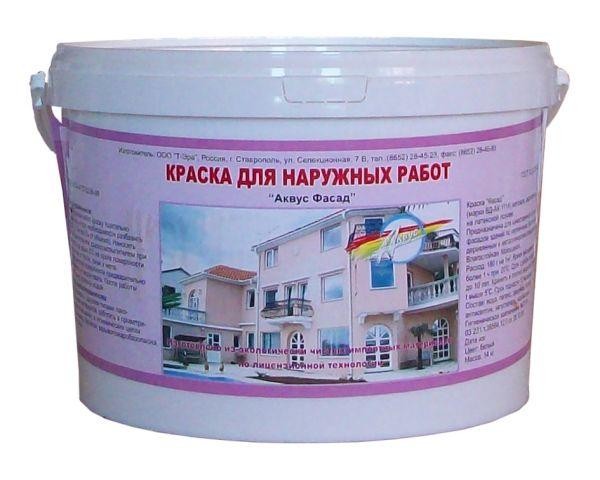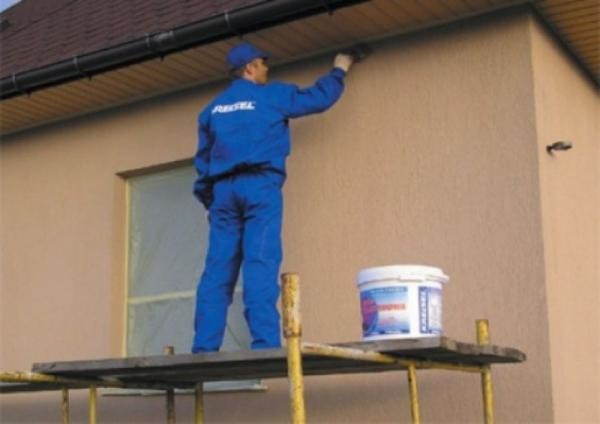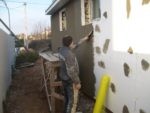Facade plaster paint for outdoor use is an excellent solution for home decoration. The variety of types, colors and textures allows you to bring to life any design idea.
About types of facade paints
The modern market for materials for construction and repair is replete with assortment. The choice of facade paints is no exception. The most common types are:
- Acrylic, the main advantage of which is to create a sufficiently strong protective film after drying. The film protects the facade from negative environmental influences.
- Latex, used for both exterior and interior facade works. Thanks to the water base, they have excellent adhesion. Latex paints are durable and can withstand harsh weather conditions.
- Silicate, used for painting surfaces containing lime. Equally well suited for work with bricks, concrete and facades. The advantage of this wear-resistant and aggressive material is its durability.
- Textured, with the help of which all kinds of decorative coatings are created not only on the facades of buildings, but also on other structural elements. Textured paints cannot withstand serious loads, but they do not require a carefully prepared surface for application - chips at the corners and cracks in the walls will be an equally good base.
It is worth noting that when choosing facade paints for plaster, it is important to take into account the type of plaster: if it is supposed to be silicate, then the paint should also be silicate. For mineral plaster, mineral facade paint is suitable.

The best facade paints for plastering are acrylic and acrylate.
They form a unique vapor-permeable coating that is also resistant to moisture. But due to the expensive components, the price of such materials is high. Therefore, the most common type is latex facade paint. These are practically the same acrylic formulations, but with the addition of a dispersion containing latex. Cheaper components of such paints lead to frequent repairs of facades due to their low durability and not the highest operational properties - the coating begins to fade in the sun, crack and peel off.
As for the separation of facade paints for plaster by structure, textured and smooth paints are distinguished. Of these two types, the best coating, the most durable and resistant, is textured. They will also help hide cracks and chips (small defects on the plaster of walls and facades).
Facade preparation and subsequent painting
Painting facades is not so easy. You must first prepare the base. Preparing the facade for finishing is a more difficult task than painting the interior walls of a room. The essence of the preparation is to protect surfaces that cannot be painted: dismantling of removable parts and covering with a protective film of non-removable ones. Before starting work, it is worth checking the weather forecast: strong winds, high temperatures or rain can interfere with the painting process.
Before starting work, the paint must be mixed thoroughly, and staining of plasters containing cement should be abandoned for at least 2 weeks. The alkaline environment of the cement may not have the best effect on the color of the facade paint.

The surface of the plaster for painting must be flat, i.e. without visible defects in the form of dents, bumps or cracks. If the surface is affected by mold or mildew, then use a brush or spatula to clean it. The cleaned facade is washed with water and allowed to dry.
The facade is painted with a spray gun, brush or roller. The shorter the pile on the roller, the smoother the surface will be. If using a gun, check the thickness of the paint and compare it with the instructions for the gun.
When using a roller or brush, alternate vertical and horizontal strokes for maximum uniform coverage. After the time specified by the manufacturer, it is necessary to apply a second coat of facade paint. A break in work can be done only after the layer is completely ready.

The ingress of moisture and dust on a freshly painted surface is not allowed.
Maintenance of painted surfaces is simple and consists in wiping them with a damp sponge or cloth at least once a year.
Conclusion on the topic
Facade paint applied to plaster not only preserves, but also improves its operational properties. The protective layer formed by the material allows the plaster to breathe and remove moisture, since it does not close its pores.

All types of modern facade paints are created taking into account the materials on which they will be applied. When developing new types of finishing materials, take into account the difficult weather conditions in which the operation of structures with this type of surface coating will take place.
After processing, the surface of the facade acquires an attractive appearance.
It is worth noting: most of the facade paints are water-based, which almost completely eliminates the appearance of unpleasant odors during the application process, facilitates the work. Layers of facade paints not only provide long-term protection of the coating, but also hide its minor defects.
Related entries:





